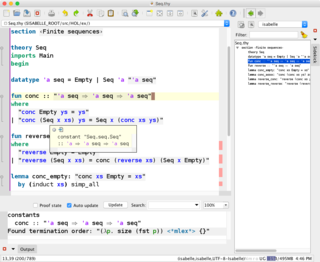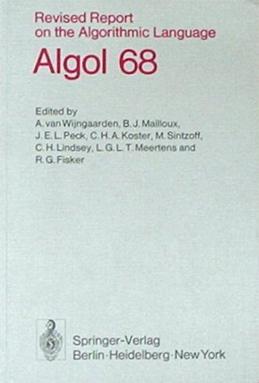Related Research Articles

In mathematics and computer science, an algorithm is a finite sequence of rigorous instructions, typically used to solve a class of specific problems or to perform a computation. Algorithms are used as specifications for performing calculations and data processing. More advanced algorithms can use conditionals to divert the code execution through various routes and deduce valid inferences, achieving automation eventually. Using human characteristics as descriptors of machines in metaphorical ways was already practiced by Alan Turing with terms such as "memory", "search" and "stimulus".
C is a general-purpose computer programming language. It was created in the 1970s by Dennis Ritchie, and remains very widely used and influential. By design, C's features cleanly reflect the capabilities of the targeted CPUs. It has found lasting use in operating systems, device drivers, and protocol stacks, but its use in application software has been decreasing. C is commonly used on computer architectures that range from the largest supercomputers to the smallest microcontrollers and embedded systems.

JavaScript, often abbreviated as JS, is a programming language that is one of the core technologies of the World Wide Web, alongside HTML and CSS. As of 2023, 98.7% of websites use JavaScript on the client side for webpage behavior, often incorporating third-party libraries. All major web browsers have a dedicated JavaScript engine to execute the code on users' devices.

A Java virtual machine (JVM) is a virtual machine that enables a computer to run Java programs as well as programs written in other languages that are also compiled to Java bytecode. The JVM is detailed by a specification that formally describes what is required in a JVM implementation. Having a specification ensures interoperability of Java programs across different implementations so that program authors using the Java Development Kit (JDK) need not worry about idiosyncrasies of the underlying hardware platform.
ML is a functional programming language. It is known for its use of the polymorphic Hindley–Milner type system, which automatically assigns the data types of most expressions without requiring explicit type annotations, and ensures type safety; there is a formal proof that a well-typed ML program does not cause runtime type errors. ML provides pattern matching for function arguments, garbage collection, imperative programming, call-by-value and currying. While a general-purpose programming language, ML is used heavily in programming language research and is one of the few languages to be completely specified and verified using formal semantics. Its types and pattern matching make it well-suited and commonly used to operate on other formal languages, such as in compiler writing, automated theorem proving, and formal verification.
Pascal is an imperative and procedural programming language, designed by Niklaus Wirth as a small, efficient language intended to encourage good programming practices using structured programming and data structuring. It is named after French mathematician, philosopher and physicist Blaise Pascal.
In computer science, control flow is the order in which individual statements, instructions or function calls of an imperative program are executed or evaluated. The emphasis on explicit control flow distinguishes an imperative programming language from a declarative programming language.
In computer science, denotational semantics is an approach of formalizing the meanings of programming languages by constructing mathematical objects that describe the meanings of expressions from the languages. Other approaches providing formal semantics of programming languages include axiomatic semantics and operational semantics.
Standard ML (SML) is a general-purpose, modular, functional programming language with compile-time type checking and type inference. It is popular for writing compilers, for programming language research, and for developing theorem provers.
The Vienna Development Method (VDM) is one of the longest-established formal methods for the development of computer-based systems. Originating in work done at the IBM Laboratory Vienna in the 1970s, it has grown to include a group of techniques and tools based on a formal specification language—the VDM Specification Language (VDM-SL). It has an extended form, VDM++, which supports the modeling of object-oriented and concurrent systems. Support for VDM includes commercial and academic tools for analyzing models, including support for testing and proving properties of models and generating program code from validated VDM models. There is a history of industrial usage of VDM and its tools and a growing body of research in the formalism has led to notable contributions to the engineering of critical systems, compilers, concurrent systems and in logic for computer science.

The Isabelle automated theorem prover is a higher-order logic (HOL) theorem prover, written in Standard ML and Scala. As an LCF-style theorem prover, it is based on a small logical core (kernel) to increase the trustworthiness of proofs without requiring — yet supporting — explicit proof objects.

Universal Plug and Play (UPnP) is a set of networking protocols on the Internet Protocol (IP) that permits networked devices, such as personal computers, printers, Internet gateways, Wi-Fi access points and mobile devices, to seamlessly discover each other's presence on the network and establish functional network services. UPnP is intended primarily for residential networks without enterprise-class devices.

In computer science, conditionals are programming language commands for handling decisions. Specifically, conditionals perform different computations or actions depending on whether a programmer-defined Boolean condition evaluates to true or false. In terms of control flow, the decision is always achieved by selectively altering the control flow based on some condition . Although dynamic dispatch is not usually classified as a conditional construct, it is another way to select between alternatives at runtime. Conditional statements are the checkpoints in the programe that determines behaviour according to situation.
dc is a cross-platform reverse-Polish calculator which supports arbitrary-precision arithmetic. Written by Lorinda Cherry and Robert Morris at Bell Labs, it is one of the oldest Unix utilities, preceding even the invention of the C programming language. Like other utilities of that vintage, it has a powerful set of features but terse syntax. Traditionally, the bc calculator program was implemented on top of dc.
In functional programming, a monad is a structure that combines program fragments (functions) and wraps their return values in a type with additional computation. In addition to defining a wrapping monadic type, monads define two operators: one to wrap a value in the monad type, and another to compose together functions that output values of the monad type. General-purpose languages use monads to reduce boilerplate code needed for common operations. Functional languages use monads to turn complicated sequences of functions into succinct pipelines that abstract away control flow, and side-effects.

ALGOL 68 is an imperative programming language that was conceived as a successor to the ALGOL 60 programming language, designed with the goal of a much wider scope of application and more rigorously defined syntax and semantics.
The Guarded Command Language (GCL) is a programming language defined by Edsger Dijkstra for predicate transformer semantics in EWD472. It combines programming concepts in a compact way. It makes it easier to develop a program and its proof hand-in-hand, with the proof ideas leading the way; moreover, parts of a program can actually be calculated.

In computer science, recursion is a method of solving a computational problem where the solution depends on solutions to smaller instances of the same problem. Recursion solves such recursive problems by using functions that call themselves from within their own code. The approach can be applied to many types of problems, and recursion is one of the central ideas of computer science.
The power of recursion evidently lies in the possibility of defining an infinite set of objects by a finite statement. In the same manner, an infinite number of computations can be described by a finite recursive program, even if this program contains no explicit repetitions.

Oxygene is a programming language developed by RemObjects Software for Microsoft's Common Language Infrastructure, the Java Platform and Cocoa. Oxygene is based on Delphi's Object Pascal, but also has influences from C#, Eiffel, Java, F# and other languages.

In computing, ATS is a programming language designed to unify programming with formal specification. ATS has support for combining theorem proving with practical programming through the use of advanced type systems. A past version of The Computer Language Benchmarks Game has demonstrated that the performance of ATS is comparable to that of the C and C++ programming languages. By using theorem proving and strict type checking, the compiler can detect and prove that its implemented functions are not susceptible to bugs such as division by zero, memory leaks, buffer overflow, and other forms of memory corruption by verifying pointer arithmetic and reference counting before the program compiles. Additionally, by using the integrated theorem-proving system of ATS (ATS/LF), the programmer may make use of static constructs that are intertwined with the operative code to prove that a function conforms to its specification.
References
- ↑ "Home page". OPAL Project. Retrieved 2023-11-25.